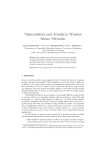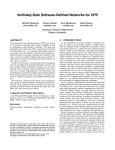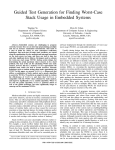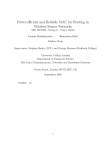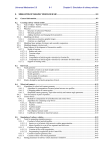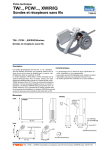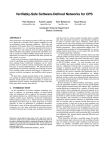Download Document
Transcript
In-Network-Aggregation as Case Study for a
Support Tool Reducing the Complexity of
Designing Secure Wireless Sensor Networks
Steffen Peter , Krzysztof Piotrowski and Peter Langendörfer
IHP GmbH, Im Technologiepark 25, 15236 Frankfurt(Oder), Germany
Email: {peter,piotrowski,langendoerfer}@ihp-microelectronics.com
Abstract—This paper shows how complex security-related
design decisions in wireless sensor networks can be made less
difficult with a proposed supporting tool. As case study in this
paper we focus on in-network-aggregation which is a promising
option to reduce network effort. We introduce several algorithms
for concealed data aggregation, each with its own benefits and
drawbacks concerning security issues but also with respect to
code size, processing overhead etc. Selecting the optimal combination requires in-depth knowledge of programming resource
constrained devices, protocols for those devices, and last but not
least significant background in security.
Our proposed configuration tool – named configKIT – has been
designed to cope with such complexity. This paper presents
how configKIT works, how it will be set up, and how it can
be applied in practice. The pre-compiler assessment process
considers memory, energy and security parameters and provides
reliable application-dependent configurations to the developer
before a single line of code is written. The approach can reduce
development time significantly and enables even complex and
sophisticated security algorithms to a broader public.
Keywords: Configuration, Wireless Sensor Networks, Security, InNetwork Aggregation
I. I NTRODUCTION /M OTIVATION
Configuration and development of wireless sensor networks
(WSN) in practice is a challenging, time-consuming, and error
prone task. Programming such severely constraint devices requires to respect many different aspects, for example code size,
processing overhead and energy consumption. If additionally
security aspects and effects of module interactions have to
be considered, the task becomes so complex even experts
make mistakes. In best case such errors merely increase
the development time, for example if after compilation the
program is too large for the applied hardware. In worst case
the development error will compromise security and other
properties unnoticed over the lifetime of the network.
For software development for personal computers several
tools are available that reduce development time while respecting complex dependencies like security and interoperability.
For example model driven [1] tools like VEST [2] support
the development with effective composition, configuration, and
the associated dependency analysis, even checking security
properties. However such tools do not respect the constraint
properties of WSNs. Dedicated tools for WSNs [3], [4] usually
propose own programming methologies. They help to improve
the implementation process of WSNs but do not directly
allow reusing existing solutions, what clearly reduces the
design space but also disables many specialized state-of-the-art
solutions.
A promising approach that enables flexibility and high performance is the usage of small specialized modules and to connect them directly without overhead structure or inter-module
communication. The idea has been realized in nesC/TinyOS
[5], which we are also using in our project. It merges all
required components to one block what promises to be very
memory-efficient and results in reduced computational overhead. Beside the problem of keeping an overview of a large
set of small modules the major issues of such programs are
development and maintenance costs. The substitution of one
module may affect many other modules. It is particularly the
case with respect to security properties. An alternation of
a security profile that eventually exchanges several security
protocols and modules would correspond to a completely new
development of the system.
We have developed a tool named configKIT that promises
to cope with the complexity of implementing WSNs. The
tool proposes suitable configuration, i.e. units of functional
modules, based on brief inputs of application requirements.
Therefore it uses a repository that contains the hardware
information of the nodes and a database of software modules
and properties.
This paper will study how configKIT can help mastering
the complexity of the particular case in-network aggregation
(INA). Therefore we briefly introduce INA and applicable
INA-algorithms in Section II and present implementation
results in Section III. Section IV introduces the configuration
tool and Section V demonstrates how the database will be set
up with the INA-implementation results. Finally Section VI
demonstrates how other developers can use configKIT and the
embedded data to reduce their development time while easily
coping with the complexity of the different algorithms.
II. I N -N ETWORK AGGREGATION
A major application scenario for WSNs is monitoring
environmental data that is transmitted to a central point (sink).
An obvious solution is to send all packets from the sensors to
the sink. Since sensors can be outside the direct radio range
intermediate nodes forward the messages through the network.
This straightforward solution can be easily implemented but
However, using standard cryptographic libraries such as
tinySec [7] the HBH-INA approach easily enables secrecy over
the wireless link while reducing the transmitted number of
packets.
B. Concealed Data Aggregation
Fig. 1. Principle of in-network aggregation: Sensors send their values to
aggregator nodes that combine the data to one data packet
would need a lot of energy for the transmission and forwarding
of the packets. Since sending one bit consumes the same
amount of energy as executing 50 to 150 instructions on sensor
nodes [6], omitting as much network traffic as possible is a
substantial task in the area of designing WSN applications.
A well known approach that reduces the energy required for
packet transmission in the sensor-to-sink scenario is the innetwork aggregation (INA). In many scenarios the sink does
not need the exact values for all sensors but a derivative such as
sum, average, or deviation. The idea of the INA is to aggregate
the data required for the determination of the derivatives as
close to the source as possible, instead of transmitting all
sensed values through the entire network. Figure 1 shows the
data gathering sensor nodes S1 ,S2 ,S3 sending their data to the
intermediate aggregator node A2,2 which aggregates the three
values and sends one instead of forwarding three packets. The
next aggregator node (A1,2 ) combines further values that are
finally sent to the sink.
A serious issue connected with the INA is the security of
the data. If the data is encrypted on the nodes with classic
methods, it can only decrypted by the sink, what would disable
the feature of INA. Waiving end-to-end (ETE) secrecy the
data could be encrypted hop-by-hop (HBH). An approach that
promises the combination of ETE-security and INA is the
concealed data aggregation (CDA). CDA allows aggregating
encrypted values on the intermediate nodes without decryption. The following subsections present applicable approaches
of secure INA for WSNs.
A. Hop-by-Hop Encryption
Hop-by-hop encrypted aggregation encrypts the data sent
over the wireless link so that potential eavesdroppers cannot
extract the actual data. Each intermediate node decrypts the
data so that it can be processed, i.e. aggregated. Finally the
node encrypts the result and sends the encrypted data to the
next hop. The HBH approach has the drawback that the data
must be decrypted and re-encrypted on every aggregation node
which is clearly unfavorable from the energy consumption
point of view. Another critical disadvantage is the missing
feature of end-to-end protection. It poses a risk if intermediate
nodes can be accessed or compromised, which is a sensible
attack scenario for WSNs.
Concealed Data Aggregation (CDA) is an improved version
of the INA, which, in contrast to HBH, ensures the ETEprivacy, i.e. the encrypted values do not need to be decrypted
for the aggregation. Instead, the aggregation is performed on
encrypted values and solely the sink can decrypt the result.
The fundamental idea of CDA are privacy
homomorphism functions that have the property:
enc(a + b) = enc(a) ⊕ enc(b), i.e. an operation on two
encrypted values has the same result as the encryption of the
sum of the two unencrypted values.
Though it is not the purpose of this paper to extensively
explain and discuss the algorithms of CDA approaches, the
next few subsections introduce three schemes for WSNs, since
it will help to follow the property assessments later in the
paper. A more extensive discussion can be found in [8].
1) CaMyTs: A key stream based CDA approach was proposed in [9] by Castelluccia, Mykletun, and Tsudik. The idea
is to perform a modular addition of a classic stream cipher
and with the sensed data. Each sensor uses a different pseudo
random stream cipher. For encryption, the plaintext is simply
added to the current key of the stream modulo the length
of the key space. The sink has to subtract the corresponding
key stream to obtain the plaintext again. CaMyTs is provable
secure and well suited for the application on WSNs since
only one modular addition is required for encryption and
aggregation. A problem is the decryption, which requires
exactly the same key streams of each individual sensor node.
Processing all the streams is not only a computational problem,
but the sink that decrypts the aggregated values must also stay
synchronized with each key stream and it has to know which
sensor data is part of the aggregate.
2) Domingo-Ferrer: In [10] Domingo-Ferrer introduced a
symmetric PH (DF) scheme that also has been proposed as
efficient CDA system for WSNs in [11]. It is a symmetric
algorithm that requires the same secret key for encryption and
decryption. The aggregation is performed with a key that can
be publicly known. It is required that the same secret key is
applied on every node in the network. Though it is known
that the algorithm has security flaws, it can be considered as
applicable for most scenarios in sensor networks as long as
long term secrecy is not important. Since the plaintext will be
split in several segments the ciphertext is slightly larger than
the plaintext.
3) Hybrid: In [12] a hybrid (hCDA) approach has been proposed that combines two existing CDA schemes to a combined
one. It executes the both embedded schemes successive while
obtaining the additive privacy homomorphic property. The
idea was motivated by the observation that all schemes have
security flaws, that could be overcome with a combination of
two schemes. In particular the combination of CaMyTs and
TABLE I
OVERVIEW OF THE FOOTPRINT OF THE IMPLEMENTED AGGREGATION APPROACHES IN THE 85- NODES - NETWORK
Alg.
No INA
No Crypt
INA
H2H Encr.
INA
without
encrytion
CaMyTs
DF
Hybrid
CaMyTs
and DF
Node
Sensor
Aggregator
Base
Sensor
Aggregator
Base
Sensor
Aggregator
Base
Sensor
Aggregator
Base
Sensor
Aggregator
Base
Sensor
Aggregator
Base
Size
ROM
RAM
[byte]
[byte]
12468
271
11586
321
11632
273
15120
468
15694
548
14548
500
12490
271
11834
321
11632
273
15460
347
14608
373
14794
1311
13749
332
12942
374
12972
354
17070
464
15994
478
16274
1428
DF seems to be promising. With the improved protection also
the effort for en/decryption clearly increases because the two
embedded schemes result in two encryptions that have to be
performed on the nodes.
III. CDA I MPLEMENTATION R ESULTS
This section describes the steps that are required to implement the INA schemes applying standard methods. The
implementation results will deliver the input required for
setting up the configKIT database in Section V.
For practical comparison we wrote a small application that
does nothing but sending stored value from the sensor nodes to
a sink. We simulated a network with one sink, four aggregator
notes as first level aggregators, 16 aggregator nodes as second
level, and 64 data-delivering sensor nodes. So the initial
situation can be stated: We have network and task and we
are looking for the best algorithm that forwards the aggregated
values from the sensor nodes to the sink. We are not interested
in the precise sensor readings but in an average value, i.e. the
sum of the single readings and the number of values.
We implemented the application in TinyOS. For the network
we used the standard TinyOS ActiveMessage modules, and
additionally the Timer and the LEDs of the simulated sensor
node. The application is similar for all tested cases. The only
difference is the applied INA-algorithm.
The following INA approaches have been investigated:
• No INA (our code)
• Hop-by-Hop (StreamCipher taken from [7])
• INA without encryption (our code)
• CaMyTs (code from original authors [9])
• DF (code from authors of [11])
• Hybrid CDA (combining code written by us)
Since the source codes are from different authors we already
had the first problem harmonizing the interfaces. For all but
CaMyTs it was sufficient to slightly adapt the interfaces. For
CaMyTs we wrote a wrapper.
Traffic
Packets
Total Size
[number]
[byte]
214
4922
106
2438
106
2438
106
2438
106
2862
106
2862
Duty Cycles
per epoch
per Node
109980
230584
319460
95980
78325
62778
94914
74016
57993
115717
71934
1124207
95443
84287
71108
115906
84270
1135265
The code was compiled for micaz [13] nodes and simulated
with Avrora version 1.7.105 [14]. Avrora is also the source the
estimated packet count and sizes and the CPU duty cycles.
Table I shows the results for each role and algorithm. The
first two rows show the memory consumption (ROM and
RAM). It is not surprising that the no in-network-aggregation
is the smallest and the hybrid has the largest code size. It
was also expected that the base-node of CaMyTs and hCDA
(that contains CaMyTs) requires the most dynamic memory,
because it has to store each sensor’s private key.
It is a bit surprising that CaMyTs is larger than DF, despite
the algorithm should not be significantly more complicated. It
is apparently caused by the more flexible CMT implementation
and the currently still required wrapper. However, the actual
reason – and here we initially made a wrong assumption – is
that CaMyTs needs a StreamCipher that requires significant
memory and energy.
The number of packets in our simulation is as expected.
These results could have been computed without actual implementation. Though the network is not severely large, the
packet count for the no-INA is already the double of all INA
approaches. Packets of DF and hybrid are slightly larger than
packets for the other three CDA algorithms because DF (that
is also part of hCDA) has a larger ciphertext. This table (as
well as the current implementation) does not consider potential
packet loss or not-responding nodes. It can be expected that
it would increase the total packet size for the CaMyTs based
simulations.
The probably most interesting numbers are the computation
cycles per epoch. The micaz has roughly 8 million cycles per
second. Most approaches have a utilization of about 1 percent.
The duty time includes everything the CPU has to perform,
i.e. beside the cryptographic operations, also receiving and
sending of packets. The actual energy consumption required
for radio, board, memory are not considered here. The No-INA
approach needs much more computation efforts than expected.
A. Architecture
The general notion of configKIT is shown as Figure 2.
Based on the three inputs hardware description, module
description, and application description a module selection
algorithm computes configurations that:
•
Fig. 2.
Structure of configKIT
•
•
The CPU is very busy treating packets in the network stack.
Though for the sensor nodes the most packets do not reach the
application layer receiving and discarding them needs a lot of
additional energy. While the additional energy for aggregator
and base node was expected because they have to handle the
additional packets the extend has been surprising.
The base nodes handling the CaMyTs algorithm have
the highest load. It is caused by the required forward key
computation for each connected sensor node. This symmetric
key computation is also the reason why the sensors handling
CaMyTs need more cycles than the other algorithms.
The results show that all implementations have reasonable
memory- and energy consumption. The simulation has also
shown that the implementations are correctly working. Thus,
the decision of the most suitable algorithm for a particular
application can be primarily made based on the security
attributes discussed as discussed in [8].
Now that we have the table of implementation results
and the knowledge of the security properties we easily can
assemble the INA in practice. In Section V we show how the
data can be entered into the database of configKIT so that other
developers have the chance to exploit the results conveniently.
IV. C ONFIGURATION T OOLKIT
The introduction of the different CDA algorithms and their
different properties clearly shows the complexity of applying
sophisticated functions in WSN. In a complete application the
selection of the INA-scheme would merely be one step. Selecting the proper key-distribution-scheme and a transport/network
protocol are other apparent decisions that have to be made. An
actually secure CDA approach can turn worthless if the keys
are distributed without secrecy, or if the slightest fluctuations
in the network path can destroy all results.
In particular for tinyOS an abundance of great tools and
implementations is available. However, even for experts it
is hardly possible to keep an overview over all modules,
their properties, requirement and side-effects. This is why we
have developed the configuration supporting tool ’configKIT’
that on one hand offers the enormous set of state-of-theart approaches and implementations while on the other hand
provides good accessibility that eventually concludes in an
accelerated development process.
•
can be combined to one software image running on the
intended node (compatibility of interfaces)
are compatible to the available hardware (compatibility
to hardware)
fulfill the requirements semantical and functional requirements of the application
fulfill the security requirements
The software configuration contains suitable modules and
a prediction of memory and energy consumptions, and an
assessment of the security properties. The result will not
be one prototypical application framework that is slightly
tailored for each purpose, but a newly computed composition
of modules with each configuration process.
B. Inputs to the Selection Process
The decisions of the security compiler are based on the
following data:
1) Hardware Description: The Device Information incorporates data of hardware and operating system of the sensor
nodes. Processor type, bit width, memory size and indeed
sensors which are available or supported. Extended properties
are available battery power, life time but also quality or
classification of sensor readings. All these data is stored in a
device database. A user can pick the hardware that is available
or define a new hardware and store it in the database. The
footprint (i.e. memory, CPU) of the particular device are the
constraints the software selection process has to respect.
2) Module Description: The Module Description is a second database in the configKIT repository. It incorporates all
available software modules, their dependencies, requirements
and properties. It also includes the modules’ footprint, like
required memory but also the security degree provided by
the specific module. It is a network of interfaces and implementations. Modules are connected to modules, they use, by
interfaces – just like in tinyOS. Interfaces can be provided by
more than one module, what reflects the design options the
developer has. The module description will be described in
more detail in Section V.
3) Application Description: The Application Description is
the third element of the security compiler. Virtually it points
on the hardware, modules and requirements in the module
description. It provides the initial conditions for the compiler.
The description can be very precise or quite abstract. So
a developer can chose a particular algorithm, but it is also
possible to ask for a routing that has good security features.
The actual application module is also a module that usually
uses the other modules. Consequently it is included in the
Module Description.
C. Selection Process
The selection algorithm composes the proper configurations
that satisfy the requirements of the application description
using the software repository and hardware properties. The
selection process is the ’brain’ of configKIT. Briefly, it:
•
•
•
•
builds a dependency graph based on available modules,
selects the modules that are explicitly required by the
application description,
starts a backtrack algorithm that looks for all sets of
modules that satisfy the application needs,
filters the configurations that satisfy the security and
energy requirements.
The algorithm traverses through the graph and ’tries’ each
possible implementation-alternative for each required interface
until either the requirements are fulfilled or no modules can
be found that match a dependency. Though the algorithm
theoretically is NP-complete, optimizations and the natural
structure of dependencies help to boil down the practical
efforts. Currently our database contains 60 modules and the
run time is less than 0.1 sec on a Pentium processor.
V. S ETTING UP CONFIG KIT FOR INA
In this section we explain the steps required for setting up
configKIT so that at the end it is aware of the properties of
the different approaches. First we have to set up the interfaces,
then add the modules, then determine and set the properties
of the modules so that finally we can add an application that
uses the available interfaces.
A. Adding the interfaces
The actual process of adding interfaces to the database is
quite straightforward. We select the name of the new interface
and set whether the interface is an actually implemented interface or a virtual interface. Virtual interfaces can be considered
as an abstract class as kind of mother class for a set of specific
interfaces. In case of INA, we define INA as the abstract
interface. Later this abstract interface can be addressed by an
application or another module that wants to use INA. It will
be task of the selection algorithm to find and to assign suitable
implementations.
Then we add the actual interfaces: Hop-by-Hop, CDA and
hCDA (hybrid CDA). The dedicated specialized interfaces are
needed if an application explicitly uses one interface. For
example if the application developer wants the application to
use Hop-by-Hop then he/she connects the application module
with the HbH-interface. Then the other INA-approaches will
never be considered as option for this module. The additional
classification of interfaces also improves the understandability
and maintenance and helps addressing (sub-)sets of interfaces.
It implicitly allows a level of fuzziness because applications
can pick either direct modules (e.g. HbH), small sets (e.g.
CDA), or general classes (e.g. INA).
Fig. 3. Detail of a configKIT dependency graph: boxes are modules, ellipses
are interfaces, black arrows are use/provide, red arrows are ’is-relations’.
B. Adding the modules
In the second step, the modules will be added to the repository. The modules either provide or use available interfaces.
In our INA case we add:
• INA without encryption provides CDA (we consider no
encryption as weakest form of encryption)
• Domingo Ferrer (DF) provides CDA and uses a random
interface
• CaMyTs provides CDA and uses a StreamCipher
• HbH provides HbH and uses a StreamCipher
• hybrid CDA (hCDA) provides hCDA and uses two CDAs
We presume that the other interfaces (Random and StreamCipher) have already been defined.
As for the interfaces we can also define abstract classes
that can combine a set of modules in a group. In our case
we add the abstract module CDA and assign the specific
modules (hybrid CDA, INA w/o encr., CaMyTs, DF). With
the abstract module CDA we can later address the set of
semantically similar CDA-modules. Finally we have to add the
application module. An application is just another module that
uses other interfaces. Our simple application that does nothing
but sending aggregated values, requires a network interface
and the INA-interface. All interfaces and modules mentioned
so far can be seen in Figure 3. It is a detail of the screen shot
of the configuration tool emphasizing the CDA part.
C. Setting the Properties of the Modules
When the modules and dependencies have been described
the properties of the modules can be set. Currently configKIT
supports the properties memory consumption, security properties (reliability, secrecy and integrity), and energy assessment.
1) Memory consumption: Estimation of memory consumption is probably the easiest of the properties. One could expect
that it is sufficient to measure the size of the single modules
and add them up at the end of the assessment process to get the
size of the application. But there are several issues that have to
be considered. First, memory has to be differentiated between
RAM and ROM. In particular RAM is severely constraint on
most WSN nodes, while usually sufficient ROM in the flash
memory is available.
Another problem is that memory consumption differs with
the applied hardware. A module compiled for the mica node
will not have the same size as for an MSP430. Compiler
optimizations or other optimization-effects caused by the connection of the modules can additionally affect the result. For
example code that is not actively used in a specific configuration will be usually not included in the binary image. Another
example is a storage module that stores a cryptographic key. If
it stores the key for a 256 bit encryption it needs more space
than storing a 128 bit key. Thus, the memory usage cannot be
precisely determined before the complete image is assembled.
Since compiling every considerable configuration is not
feasible we apply the following approach: In the evaluation
phase we use the straightforward addition of module sizes.
We know that the result is not perfectly precise but is a
good estimation that helps to assess the memory consumption.
Consequently the memory property is a set of two numbers,
i.e. RAM and ROM, that describe the module size.
2) Security Properties: Security properties are not as easy
to assess as memory size. The first problem is that there exist
nothing like an obvious security metric that can be applied.
In our first approach we assigned each module an subjective
security degree on a scale from no security to very secure.
Though it already helped to filter weak modules the results
were not always satisfying. Indeed one number cannot describe
the security properties of a complete toolbox. If the application
needs high integrity but does not need concealment it is indeed
not necessary to embed a high secure stream cipher. This is
why it is useful to specify the particular security classes.
At this point of development the security of a module is
defined by three numbers, rating the security strength of the
properties robustness, secrecy and integrity. The notion of
classification allows tackling the security degrees individually.
If an applications needs security in terms of robustness and
does not care for concealment the expected outcome will
be different than vice versa. That classification can either
be directly set, or – in case the module uses other security
relevant modules – it can be derived from the modules a
module uses. The derived assessment is a function that apply
the algebraic functions (+,-,MIN,MAX). For example if we
assume the security properties for the hybrid CDA are the
best of its two sub-modules, then the three security properties
of the hybrid CDA would be:
• integrity = MAX($1.integrity, $2.integrity);
• secrecy = MAX($1.secrecy, $2.secrecy);
• robustness = MAX($1.robustness, $2.robustness);
while $1 and $2 point to the first and second connected module
TABLE II
I NITIAL INA ENERGY AND SECURITY ASSESSMENT
Alg.
No INA
H2H Encr.
INA w/o encr
CaMyTs
DF
Hybrid
Integrity
1
2
1
3
1
MAX($1,$2)
Secrecy
0
1
0
$1
2
MAX($1,$2)
Robustness
1
1
0
1
2
MAX($1,$2)
Energy
0
1
3
1
2
0
respectively.
CaMyTs directly forwards the secrecy parameter of the used
StreamCipher (secrecy = $1.secrecy), so that the secrecy of
CaMyTs is determined by the secrecy of the StreamCipher.
The assessment of the other INA modules is a straightforward classification on a subjective metric from 0 (not secure)
to 3 (very secure). The classification is based on the results in
[8]. Table II shows the assessments.
Please be aware that such a simplistic security assessment
does not hold the expertise of an security expert, but it helps
evaluating and filtering in the early phase of the development.
3) Energy Consumption: In the current version we treat
the energy property similar to the security properties. Though
objective metrics for energy are available, e.g. energy or cycles
per operation, we still lack an approach to harmonize them
so that they can be compared. The INA approaches for sure
can be compared by cycles per epoch, as it is done in Table I.
However the data could only be used in direct comparisons and
would not have any significance in comparison with routing
protocols for example.
With our proposed subjective metric, i.e. ’0’ for bad and ’3’
for very good, it is easier to combine different protocols, and
we still keep the option to compare similar protocols directly.
Clearly that approach is not perfectly satisfying, but as the
properties for security and memory it can help to filter suitable
or not suitable modules.
D. Incremental Extension of the database
Up to this point we showed how to set the initial set of
modules. Since we added six modules and some interfaces
the process of adding modules appears a bit complicated. In
practice the complexity is not so high because most of the time
just one module will be added per time. Considering we want
to add a new CDA algorithm, all what has to be done is to
add new interfaces if required and then add the new module
with its properties. If the interface is connected to the INA
the new module will automatically considered the next time
configKIT looks for suitable configurations.
This way we hope other developers can be encouraged to
add their modules to the database.
VI. C ONFIGURING INA WITH CONFIG KIT
In the previous section we explained how to set up the repository of configKIT.In this section we show how developers –
with different level of experience – can use confgKIT and
this way can exploit the stored data to easily configure their
WSN-application with INA.
Fig. 5. Initial configuration of the INA-application: Simple network protocol
and simple INA algorithm are small but insecure
Fig. 4.
Selection dialog box sets the inputs for the application description
As introduced in Section IV-B3 the application description,
which is the input of the selection process, is mainly a
set of pointers to modules in the software repository with
additional requirements. The selected modules can be both
abstract modules or concrete modules. Additionally global
requirements like available hardware has to be set.
An exemplary selection dialog can be seen as Figure 4. In
that example the user chose the abstract modules Middleware,
CDA and a Transport Protocol with medium security requirements. The hardware in the screen shot is a micaz node.
In our simpler CDA example, the user already has written
the application top module (INA TestApp in Figure 2) and
is looking for suitable modules that can be connected. Without additional requirements the request would be just: ’INA
TestApp’. The result can be seen as Figure 5. The network
function is ActiveMessage and the preferred INA approach
is INA without aggregation. Since no security requirements
were given, configKIT selected the smallest solution. The
sec: (0|0|0) indicates that no security features are provided. The predicted memory consumption is 11 kBytes and
the predicted energy consumption is low.
If the secrecy should be increased it is sufficient to change
the secrecy radio button from ’0’ to ’2’. Then DF would be the
preferred INA approach. CaMyTs and hCDA are alternatives
that are also listed, but they are larger and need more energy.
The resulting security parameters are 1 for integrity, 2 for
secrecy, and 0 for robustness. Robustness is 0 because simple
ActiveMessage is not a reliable network protocol. Increasing
the robustness requirement would add reliable network or
transport protocols.
Increasing the required level of integrity to ’2’ disqualifies
DF as proper solution because its integrity property is too
weak. Then CaMyTs with an StreamCipher will be chosen
instead. Figure 6 shows the output in case all three security
parameters are set to ’2’, i.e. ’good’. Since CaMyTs does not
provide sufficient robustness the only remaining choice is the
hybrid CDA which applies both CaMyTs and DF. The need
for a robust network protocol added the Transport and network
protocols DTSN/DSDV [15]. It can be seen that all security
requirements are at least ’good’ (’2’). It can also be seen that
the complexity of the system is already quite high. The total
memory prediction is more than 25 kBytes (4kB RAM), so
that it is still acceptable for the micaz node.
All tests so far could be described in one line as part of the
application description. The missing configurations of Table I
(hybrid without reliable transport protocol and Hop-by-Hop)
are apparently no obvious choices. Actually this is reasonable
because using HbH is questionable if CDA can be applied
and to use a heavy weight CDA without reliable transport
is also not sensible. However, if the developer – and we for
comparison reason – is looking for the assessment of such
configurations, additional inputs in the application description
can be set. In both cases it is sufficient to remove the security
requirements and to add the specific module to the application.
Table III summarizes the required inputs for each case
introduced in Table I. It shows also the predicted total memory
consumption and the assessment of energy and security. The
selections and proposed configuration based on the inputs
are reasonable, and the predicted memory consumption cor-
Fig. 6. Output of of the configuration process if all security properties have
to be good or better
TABLE III
OVERVIEW OF EXAMPLARY INPUTS , THE RESULTING CONFIGURATIONS AND THEIR ESTIMATED PROPERTIES
Alg.
No INA
H2H Encr.
INA w/o encr
CaMyTs
DF
Hybrid (secure network)
Hybrid (no secure network)
Inputs
no INA TestApp
INA TestApp + HbH
INA TestApp (no sec)
INA TestApp (high secrecy)
INA TestApp (good robustness)
INA TestApp (good robustness and secrecy)
INA TestApp + hCDA
ROM (kB)
10
13
11
15
13
25
16
Integrity
0
1
0
3
1
3
3
Secrecy
1
1
0
3
2
3
3
Robustness
0
0
0
0
0
2
0
Energy
0
2
3
1
2
0
0
responds to the actual memory consumption determined in I.
The security assessments are correct considering our inputs,
though it can be discussed whether robustness has to be zero
whenever a reliable network protocol is missing. The energy
evaluation is also correct and it allows direct comparisons, but
the significance of that assessment is at least questionable.
(IST-2004-2.4.3). The views and conclusions contained herein
are those of the authors and should not be interpreted as
necessarily representing the official policies or endorsements,
either expressed or implied, of the UbiSec&Sens project
(http://www.ist-ubisecsens.org) or the European Commission.
VII. C ONCLUSIONS
[1] A. Brown, J. Conallen, and D. Tropeano, Models, Modeling, and ModelDriven Architecture (MDA). Springer Verlag, 2005, ch. Introduction:.
[2] J. Stankovic, R. Zhu, R. Poornalingam, C. Lu, Z. Yu, M. Humphrey, and
B. Ellis, “Vest: An aspect-based composition tool for real-time systems,”
in Proceedings of the IEEE Real-time Applications Symposium, 2003.
[3] L. Luo, T. F. Abdelzaher, T. He, and J. A. Stankovic, “Envirosuite:
An environmentally immersive programming framework for sensor
networks,” Trans. on Embedded Computing Sys., vol. 5, no. 3, 2006.
[4] M. J. Ocean, A. Bestavros, and A. J. Kfoury, “snbench: programming
and virtualization framework for distributed multitasking sensor networks,” in VEE ’06: Proceedings of the 2nd international conference
on Virtual execution environments, 2006, pp. 89–99.
[5] J. Hill, P. Levis, S. Madden, A. Woo, J. Polastre, C. Whitehouse,
R. Szewczyk, C. Sharp, D. Gay, M. Welsh, D. Culler, and E. Brewer,
“TinyOS: http://www.tinyos.net,” December 2005.
[6] K. Piotrowski, P. Langendoerfer, and S. Peter, “How public key cryptography influences wireless sensor node lifetime,” in Proceedings of the
4rd ACM Workshop on Security of ad hoc and Sensor Networks, SASN,
2006.
[7] C. Karlof, N. Sastry, and D. Wagner, “Tinysec: A link layer security
architecture for wireless sensor networks,” in Second ACM Conference
on Embedded Networked Sensor Systems (SenSys), 2004.
[8] S. Peter, D. Westhoff, and C. Castelluccia, “A survey on the encryption
of convergecast-traffic with in-network processing,” IEEE Transactions
on Dependable and Secure Computing, 2008, preprint available at
http://doi.ieeecomputersociety.org/10.1109/TDSC.2008.23.
[9] C. Castelluccia, E. Mykletun, and G. Tsudik, “Effcient aggregation of
encrypted data in wireless sensor networks.” in MobiQuitous. IEEE
Computer Society, 2005, pp. 109–117.
[10] J. Domingo-Ferrer, “A provably secure additive and multiplicative privacy homomorphism,” in ISC ’02: Proceedings of the 5th International
Conference on Information Security, 2002.
[11] J. Girao, D. Westhoff, and M. Schneider, “Cda: Concealed data aggregation for reverse multicast traffic in wireless sensor networks,” in IEEE
International Conference on Communications, 2005.
[12] S. Peter, P. Langendoerfer, and K. Piotrowski, “On concealed data
aggregation for wireless sensor networks,” in CCNC ’07: Proceedings of
Fourth IEEE Consumer Communications and Networking Conference,
2007.
[13] C. T. Inc., MPR / MIB User’s Manual, 2005, available
at:
http://www.xbow.com
/Support/Support pdf files/MPRMIB Series Users Manual.pdf.
[14] B. L. Titzer, D. K. Lee, and J. Palsberg, “Avrora: scalable sensor network
simulation with precise timing,” in IPSN ’05: Proceedings of the 4th
international symposium on Information processing in sensor networks,
2005.
[15] B. Marchi, A. Grilo, and M. S. Nunes, “Dtsn: Distributed transport for
sensor networks.” in Symposium on Computers and Communications,
2007.
We chose INA in this case study demonstrating our WSN
configuration tool configKIT. This scenario combines many aspects a developer of WSNs application has to face, i.e. energy
efficiency, memory consumption and levels of security. We
demonstrated how configKIT has to be set up in order to help
developers getting an overview of the different approaches,
and we showed how the data can be applied in practice.
The presented structure of the configKIT repository allows
successively extending the database so that eventually a comprehensive consideration of an abundance of modules and
approaches is not only feasible but intended.
Still the results do not satisfy in each situation. The estimations of memory usage, energy consumption and security
properties are early approaches that are subjects for refinements. However, even the presented methods already help
assessing potential configuration very early in the development
process. The results are sensible as demonstrated in Section
VI. configKIT highlights aspects a developer could easily
forget, e.g. that an actually small module depends on a large
other module, or that a robust security means does not provide
robustness unless a reliable network protocol is added. Experts
in the particular area will surely be able to find better solutions,
while average developers will get a lot of new possibilities and
understanding of complex relations.
Even without a feature like automatic implementation configKIT can reduce development time of application for WSNs.
A developer needs few mouse-clicks to define the requirements
and less than a second later a configuration is provided that
will run on the specified hardware and satisfy all the other
needs that have been defined. With the knowledge of the
right modules and their interfaces we assume that the required
adaptation of the actual implementation can be accomplished
much faster and with less errors.
ACKNOWLEDGMENT
The work presented in this article was supported by the
European Commission within the STReP UbiSec&Sens of the
EU Framework Program 6 for Research and Development
R EFERENCES










